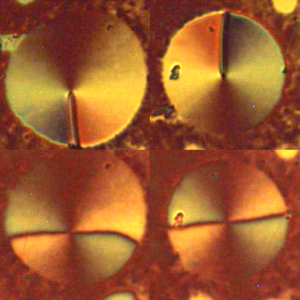
Liquid crystal alignment on soft ordered films

The long-range orientation of liquid crystals is very sensitive on the boundary conditions when in confined geometries. Typically, uniform polymer or surfactant films or patterned polymer layers are employed to impose liquid crystal anchoring. We study the patterning of nematic and cholesteric liquid crystal cells through contact with Langmuir-Blodgett films.
These soft monolayers exhibit broken symmetries and interfacial topological defects, which results in the propagation and healing of defect structure into the bulk mesogen. The films are previously self-assembled at the air/water interface where they organize into isolated sub-millimeter circular islands featuring polar nematic order with the elongated molecules anchored at a fixed angle of the interface normal (~ 45º), and a tilt orientation tangential to the circular boundary (s = +1, c = π/2).In contact with the LB-coated glass substrate, LC molecules follow the local in-plane orientation of the amphiphilic molecules in the monolayer. In the case of nematic liquid crystals, we observe the formation of either single twist-escaped or double singular arch-shaped defect loops, which are confined to the vicinity of the LB-coated plate, and are independent on the far-field boundary conditions.

When filling the cell with a CLC, the local twist imposed by the hybrid boundary conditions couples to the intrinsic cholesteric pitch, resulting in the formation of edge dislocations pinned between screw dislocations and kinks. Different three-dimensional imaging techniques (Fluorescence Confocal Polarizing Microscopy, and 2- and 3-photon fluorescent imaging) are employed to reveal the configuration of the director field.
